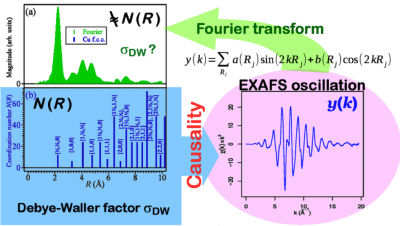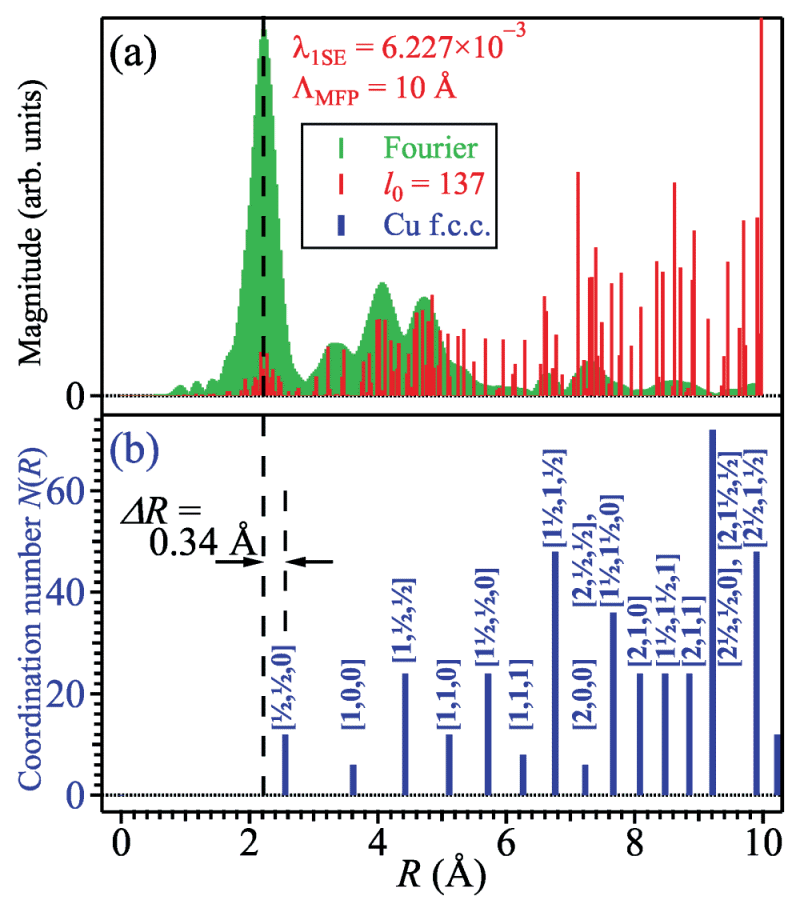Structural fluctuation evaluation in substances from measurement data New analytical method promises advances in battery and electronic device material development.
Microstructure analysis of materials is a key technology for new material research. Using an information extraction technique called sparse modeling, a collaboration of researchers led by Professor Ichiro Akai of Kumamoto University, Japan has developed the world's first method of analyzing the atomic structure and structural fluctuation in materials using only measured data. This method needs no prior assumptions about atomic-scale structure, which are required in conventional microstructure analysis methods. Among other applications, this new approach is expected to improve the functionality of and give longer life to batteries.To realize new functions and performance improvements of functional substances, such as those found in batteries and electronic devices, their structure and structural changes must be evaluated at the atomic-scale. This is because, the structure of the atoms at the nanometer scale dominates their properties. Extended X-Ray Absorption Fine Structure (EXAFS) measurements are widely used to analyze microstructures such as these on an atomic scale.
By performing a Fourier transformation on the measured spectrum of an EXAFS oscillation, microstructure information can be obtained to determine how adjacent atoms are distributed radially. However, the radial distribution obtained by this conventional method is quite different from the actual radial structure. This discrepancy is due to improper expansion with basis functions of vibrating waves having constant amplitude by Fourier transformation, despite the fact that the amplitude of the EXAFS oscillation changes noticeably within the observed range.
The amplitude changes represent structural fluctuations, which are variations in atomic distances and the mobility of neighboring atoms. These physical properties are indicated by a physical quantity called the Debye–Waller factor. This factor cannot be obtained by Fourier transformation of the EXAFS oscillation because estimating the Debye-Waller factor requires assumptions to be made about a material’s microstructure. In other words, since an analysis of the conventional EXAFS oscillation spectrum is based on a hypothetical structure, it is difficult to estimate the Debye–Waller factor unless the material microstructure is previously known.
To solve this problem, researchers focused on the fact that atoms are, in general, regularly distributed, which reflects their chemical structure and bonding states. Furthermore, the distances between atoms (atomic coordinates) are distinct, and can be considered to be “sparse”. The researchers then developed a new analytical method using a type of information extraction technology called "sparse modeling" to analyze EXAFS data. Sparse modeling was developed in the information science field, and is able to discover dominant properties in measured data even little information. In recent years, it has been used in a wide range of research fields, such as astronomy, medical science, and engineering.
Using only measured data, without any prior knowledge about a material, the new method can (1) determine the radial structure (microstructure) from an atom of interest to neighboring atoms with respect to distance, and (2) estimate the Debye–Waller factor (i.e., the structural fluctuation and mobility of neighboring atoms).
"Since we can estimate the Debye-Waller factor without any prior information about a material, we expect that this method will produce important results in several areas of materials research,” said lead researcher, Professor Ichiro Akai of Kumamoto University. “Particularly for novel substances, such as thermoelectric materials where thermal fluctuation of adjacent atoms is important. And superionic conducting materials that require mobility between adjacent atoms. Both of these are currently attracting attention as solid electrolyte materials for secondary batteries."
In this study, the researchers applied their new method to EXAFS data from a standard sample of copper and demonstrated that the sparse modeling technique worked properly and effectively to analyze the EXAFS oscillation spectrum. Applying this method to various materials that are difficult to analyze in detail through conventional methods is expected to produce future developments.
This work was published in the "Journal of the Physical Society of Japan" on 22 June 2018.
*This research was carried out through a collaborative effort between Kumamoto University, the Kyushu Synchrotron Light Research Center, Japan Science and Technology Agency, and the University of Tokyo.
[Source]
Akai, I., Iwamitsu, K., Igarashi, Y., Okada, M., Setoyama, H., Okajima, T., and Hirai, Y. (2018). Sparse Modeling of an Extended X-Ray Absorption Fine-Structure Spectrum Based on a Single-Scattering Formalism. Journal of the Physical Society of Japan, 87(7), 074003. doi:10.7566/jpsj.87.074003
[Paper Info]
TITLE:
Sparse Modeling of an Extended X-Ray Absorption Fine-Structure Spectrum based on a Single-Scattering Formalism
AUTHORS:
Ichiro Akai, Kazunori Iwamitsu, Yasuhiko Igarashi, Masato Okada, Hiroyuki Setoyama, Toshihiro Okajima, Yasuharu Hirai
JOURNAL:
Journal of the Physical Society of Japan
DOI:
10.7566/JPSJ.87.074003
URL:
https://journals.jps.jp/doi/abs/10.7566/JPSJ.87.074003
[Fund]
(1) Japan Society for the Promotion of Science (JSPS) Grants-in-Aid for Scientific Research (KAKENHI),
(2) JSPS Grants-in-Aid for Scientific Research on Innovative Areas,
(3) Japan Science and Technology Agency (JST) Core Research for Evolutional Science and Technology (CREST),
(4) JST Precursory Research for Embryonic Science and Technology (PRESTO)
<Grant numbers>
(1) JP16H01552, JP16H04002, JP16K13824, (2) JP25120009, (3) JPMJCR1761, (4) JPMJPR17N2
[Image1]

Problems with the conventional analytical method of the EXAFS spectrum
CAPTION:
Blue lines in Figure (b) describe the correct radial structure function, N(R), as determined by the structure of the material. The N(R) has radial components (the number of coordinating atoms) at sparse interatomic distance R. As the distance increase, the N(R) increases the number of atoms (intensity of N(R)) coordinating at the same distance owing to the structural symmetry of substances. In contrary to such discrete N(R), we have obtained informations about the microstructure from a green spectrum in Figure (a), which is calculated by Fourier transformation of the EXAFS oscillation spectrum (right side of figure). This spectrum is a continuous function of the interatomic distance R, and shows the intensity decreasing as R increases. This means that as the atomic distance increases, this method cannot correctly estimate the radial structure function of coordinating atoms.
Adapted from: Akai, I., Iwamitsu, K., Igarashi, Y., Okada, M., Setoyama, H., Okajima, T., & Hirai, Y. (2018). Sparse Modeling of an Extended X-Ray Absorption Fine-Structure Spectrum Based on a Single-Scattering Formalism. Journal of the Physical Society of Japan, 87(7), 074003. doi:10.7566/jpsj.87.074003
[Image Details – All Images]
Image Credit:
Dr. Ichiro Akai
Usage Restrictions:
This image is available under the terms of the Creative Commons Attribution 4.0 License. Any further distribution of this work must maintain attribution to the author(s) and the title of the article, journal citation, and DOI.
[Image2]

Result (1) of applying sparse modeling to an EXAFS oscillation spectrum
Caption:
(a) Measured data, (b) Result after sparse modeling, (c) Residual of the result by sparse modeling of the measured data.
Akai, I., Iwamitsu, K., Igarashi, Y., Okada, M., Setoyama, H., Okajima, T., & Hirai, Y. (2018). Sparse Modeling of an Extended X-Ray Absorption Fine-Structure Spectrum Based on a Single-Scattering Formalism. Journal of the Physical Society of Japan, 87(7), 074003. doi:10.7566/jpsj.87.074003
[Image3]

Result (2) of applying sparse modeling to an EXAFS oscillation spectrum
Caption:
(a) Green: conventional Fourier transformation spectrum. Red: quasi-radial structure function extracted using sparse modeling. (b) Correct radial structure function of copper.
Akai, I., Iwamitsu, K., Igarashi, Y., Okada, M., Setoyama, H., Okajima, T., & Hirai, Y. (2018). Sparse Modeling of an Extended X-Ray Absorption Fine-Structure Spectrum Based on a Single-Scattering Formalism. Journal of the Physical Society of Japan, 87(7), 074003. doi:10.7566/jpsj.87.074003

